The Journal of the Canadian Institute of Quantity Surveyors
Le Journal de l’Institut canadien des économistes en construction

The Journal of the Canadian Institute of Quantity Surveyors
Le Journal de l’Institut canadien des économistes en construction



1
You are invited to submit articles for consideration to the editorial team of the Construction Economist. We are particularly interested in knowledge share and thought leadership, with a focus on innovation and sustainability. CIQS continues to work in elevating the profession of quantity surveying and estimating, in a manner that seeks to make these careers of choice. We welcome members and readers of this journal to contribute their subject matter knowledge as the Construction Economist continues to be the preeminent voice of construction economics in Canada.
You are invited to submit articles for consideration to the editorial team of the Construction Economist. We are particularly interested in knowledge share and thought leadership, with a focus on innovation and sustainability. CIQS continues to work in elevating the profession of quantity surveying and estimating, in a manner that seeks to make these careers of choice. We welcome members and readers of this journal to contribute their subject matter knowledge as the Construction Economist continues to be the preeminent voice of construction economics in Canada.
Should you be interested, please contact Kelsey Wright at memberservices@ciqs.org for additional information.
Should you be interested, please contact Kelsey Wright at memberservices@ciqs.org for additional information.

To promote the professional status of Institute members by establishing and maintaining high standards and ethics, and fostering excellence through education and the interchange of knowledge and partnership with industry stakeholders.
Canadian Institute of Quantity Surveyors (CIQS) Markham, ON info@ciqs.org
CIQS EDITORIAL TEAM
Chief Executive Officer
Sheila Lennon, CAE ceo@ciqs.org
Assistant Editors
Kelsey Wright, Member Services Coordinator memberservices@ciqs.org
Ajibola Soboyejo, PQS
Karen Cheung, PQS
Shane McKernan, PQS
CIQS BOARD OF DIRECTORS
Chair Tammy Stockley, PQS(F)
Vice-Chair Seán Hollywood, PQS
Past Chair Arif Ghaffur, PQS(F)
Directors
Ajibola Soboyejo, PQS
David Dooks, PQS(F)
Ibrahim Oladapo, PQS
Kerry Mohur, PQS
Marc Brown, PQS
Mykola Pulnyev, PQS
Observer, Board Wendy Hobbs, PQS(F) Observer, YQS Brandon Roy, CEC
Statements of fact and opinion contained within this journal are those of the authors, including subject matter experts. CIQS assumes no responsibility or liability for the content of such fact and opinion, nor do they represent the official policy of CIQS.
Published by / Publié par
1200 Portage Avenue, Suite 200 Winnipeg, MB R3G 0T5
T. 204-975-0415
www.naylor.com
Publisher Darryl Lazarenko
Content Andrea Németh
Layout Mahender Veer
©2025 Naylor (Canada) Inc. All rights reserved. The contents of this publication may not be reproduced, in whole or in part, without the prior written consent of the publisher.
PUBLISHED JUNE 2025/CIQ-Q0225
Canadian Publication Mail Agreement #40064978
COVER IMAGE: ISTOCK.COM/MESH CUBE
Alliancing
A significant transformation in project management

09
UPHOLDING ETHICS IN OUR PROFESSION
Recognizing the impact of professional ethics on our profession and broader industry.
16 THE ROAD TO A DECARBONIZED CANADIAN TRANSPORTATION SYSTEM
Reducing emissions while expanding infrastructure.
19 THE ART OF STANDING YOUR GROUND – A YQS’S DILEMMA Best practices for making and owning your decision.
21
CIQS ADVOCACY: ELECTION SEASON AND TRADE WARS
The importance of infrastructure in Canadian public policy.
22
PROJECT PROFILE: TRANSFORMING HEALTHCARE IN NOVA SCOTIA
QEII Halifax Infirmary Expansion Project.
24
CANADIAN CONSTRUCTION: INDICATORS OF GROWTH, COMPOSITION AND CHANGES
27 IN MEMORIAM
28
Remembering Joanne Stregger and Donald Hamlett.
WELCOME NEW CIQS MEMBERS
04 Chair’s Message
05 Message de la présidente du conseil
06 Message from the CEO
07 Message de la directrice générale
29 New Designation Holders
30 Index to Advertisers

Tammy Stockley, Professional Quantity Surveyor (Fellow) Chair, CIQS/CIQS Board Director
he 2025 CIQS Congress
Theme “Shaping Our Future: Catalysts for Progress” is fitting since the construction sector is no stranger to volatility and unpredictability, factors that have been amplified in recent years by the pandemic, shifting global supply chains, inflationary pressures, and unforeseen geopolitical events. As our industry faces an ever-evolving landscape, the importance of Professional Quantity Surveyors (PQS) and Construction Estimator Certified (CEC) professionals has never been more evident.
Our professional members play a pivotal role in ensuring that construction projects are not only feasible, but financially sound. In today’s climate, however, their expertise is more critical than ever in navigating the turbulence of market volatility and the unpredictable nature of construction costs. As Chair of the Canadian Institute of Quantity Surveyors (CIQS), I am proud to highlight the ongoing contributions of our members in addressing these challenges and securing the future of the built environment.
Some of the webinars over the past 12 months cover topics relevant to the challenging market trends that our members are facing.
• BIM Strategies for Managing Construction Cost Escalation in Canada
• Innovative Concrete Slab Technology –The Bubbledeck
• Navigating BC’s Builders Lien Act: Key Insights to Mitigate Risks & Ensure Compliance
• Trade Wars: What Tariffs Mean for CIQS Members and Exploring Solutions
• Understanding Mass Timber Costs: Maximizing Value & Efficiency
• CIQS Women’s Coffee Circle (Women in Construction)
• Delivering Construction & Infrastructure – But for the Acute Deficit in Human Capital!
• Accelerated Building Construction using Total Precast Concrete Structures
• Understanding Reserve Fund Studies
• How Ready Are We for New Green Technology?
• Perspectives of a Certified Construction Adjudicator
Construction projects have always been subject to fluctuations in material and labour costs. Recent disruptions have magnified these challenges, with price spikes for key materials such as lumber, steel, and fuel. PQS and CEC professionals help clients manage risks by predicting cost trends, assessing financial impacts of market changes, and recommending strategies to mitigate risks.
One of the most significant ways our members address these challenges is through their ability to provide accurate and timely cost forecasts. By conducting thorough market research, benchmark data, and leveraging industry intelligence, PQS and CEC professionals can anticipate price increases and advise clients on how to adjust their budgets and procurement strategies. This proactive approach enables clients to make informed decisions, even in the face of significant cost uncertainty.
Another critical aspect of managing cost unpredictability is implementing
rigorous cost control measures. PQS and CEC members excel at providing detailed cost control services that go beyond the initial budget estimates. Through regular cost reporting, value engineering, and change order management, our professionals ensure that projects stay on track financially, even when unforeseen challenges arise. Moreover, the ability to manage cash flow efficiently is vital in an unpredictable market. Our members work closely with clients to identify potential cost overruns early, enabling corrective actions to be taken before overruns escalate into major financial concerns. This level of foresight and financial scrutiny builds resilience in construction projects, ensuring that they can weather the storm of market volatility.
In times of uncertainty, collaboration is key to ensuring the success of any construction project. PQS and CEC professionals serve as trusted construction economic advisors, working alongside project stakeholder teams, contractors, and owners to find innovative solutions to cost challenges. A collaborative approach is essential in identifying alternative materials, construction methods, and procurement strategies that can help minimize costs and maximize better return on investment.
Our members can improve the accuracy and efficiency of cost estimation and project tracking with real-time updates on project costs, enabling teams to quickly respond to fluctuations in market prices and adjust as needed.
Continued on page 30

Tammy Stockley, Économiste en construction agréé « Fellow » Présidente de l’ICÉC/membre du conseil d’administration de l’ICÉC
e thème du congrès 2025 de l’ICÉC, « Façonner notre avenir : Catalyseurs du progrès », est tout à fait adapté, puisque le secteur de la construction connaît la volatilité et l’imprévisibilité ; des facteurs qui ont été renforcés ces dernières années par la pandémie, les chaînes d’approvisionnement mondiales changeantes, les pressions inflationnistes et les événements géopolitiques imprévus. Alors que notre secteur est confronté à un paysage en constante évolution, l’importance des économistes en construction agréés (ÉCA) et des estimateurs en construction certifiés (ECC) n’a jamais été aussi claire.
Nos membres professionnels jouent un rôle essentiel en veillant à ce que les projets de construction soient non seulement réalisables, mais aussi financièrement sains. Dans le climat actuel, cependant, leur expertise est plus importante que jamais en réponse aux turbulences de la volatilité du marché et la nature imprévisible des coûts de construction. En tant que présidente de l’Institut canadien des économistes en construction (ICÉC), je suis fière de souligner les contributions continues de nos membres pour relever ces défis et assurer l’avenir de l’environnement du bâtiment.
Certains des webinaires organisés au cours des 12 derniers mois couvrent des sujets en rapport avec les tendances du marché auxquelles nos membres sont confrontés.
• Stratégies de BIM pour gérer l’escalade des coûts de construction au Canada
• Une technologie innovante pour les dalles en béton – Bubbledeck
• Mieux comprendre la loi
Builders Lien Act de la Colombie-Britannique : Conseils clés pour atténuer les risques et garantir la conformité
• Les guerres commerciales : l’impact des tarifs douaniers pour les membres du ICÉC et les solutions à explorer
• Comprendre les frais du bois massif : maximiser la valeur et le rendement
• Café des femmes de l’ICÉC (Les femmes du secteur de la construction)
• Prestations de construction et d’infrastructure : que faire face au déficit important de capital humain ?
• La construction accélérée de bâtiments à l’aide de structures en béton préfabriqué
• Comprendre les études sur les fonds de réserve
• Sommes-nous prêts pour les nouvelles technologies écologiques ?
• Perspectives d’un arbitre agréé en matière de construction
S’adapter à l’évolution des conditions du marché
Les projets de construction ont toujours été soumis aux fluctuations des coûts des matériaux et de la main-d’œuvre. Les perturbations récentes ont amplifié ces défis, avec des hausses de prix pour des matériaux clés tels que le bois, l’acier et le carburant. Les professionnels ÉCA et ECC aident les clients à gérer les risques en prévoyant les tendances des coûts, en évaluant les impacts financiers des changements du marché et en recommandant des stratégies pour atténuer les risques.
L’une des façons les plus significatives dont nos membres relèvent ces défis est leur capacité à fournir des prévisions de coûts précises et opportunes. En réalisant des études de marché approfondies, des données de référence et en tirant parti de l’intelligence industrielle, les professionnels ÉCA et ECC peuvent anticiper les augmentations de prix et conseiller leurs clients sur la manière d’adapter leurs budgets et leurs stratégies d’approvisionnement. Cette approche proactive permet aux clients de prendre des décisions en connaissance de cause, même en cas d’incertitude importante concernant les coûts.
Renforcer la résilience par la maîtrise des coûts
Un autre aspect essentiel de la gestion de l’imprévisibilité des coûts est la mise en œuvre de mesures rigoureuses de contrôle des coûts. Les membres de ÉCA et ECC excellent dans la prestation de services de contrôle des coûts détaillés qui vont au-delà des estimations budgétaires initiales. Grâce à des rapports réguliers sur les coûts, à l’analyse de la valeur et à la gestion des ordres de modification, nos professionnels veillent à ce que les projets restent sur la bonne voie sur le plan financier, même en cas de défis imprévus.
En outre, la capacité à gérer efficacement les flux de trésorerie est essentielle lorsque le marché est imprévisible. Nos membres travaillent en étroite collaboration avec les clients afin d’identifier rapidement les dépassements de coûts potentiels, ce qui permet ainsi Suite à la page 30

Sheila Lennon, CAE Chief Executive Officer, CIQS
our personal brand is a combination of your values, experiences and skills, and how you are seen by others. Your brand does for your reputation what your resume does for your job search –it showcases your abilities in a way that will build trust and open doors.
One way to build your brand is to continually enhance your skill set and knowledge to make sure you always stay current on new technologies, techniques, and emerging trends. The need for continuously developing your skills has never been more important than in today’s market with the newly evolved technologies, such as AI, that impact how we live, work and play.
With the rapid advancement in AI and industry software, and the shift in corporate culture with a greater focus on employee mental health and collaborative leadership, working on soft skills is just as important as maintaining one’s technical skills and understanding of market trends. If you missed it, there is a great article written by Ibrahim Oladapo in the spring 2025 Construction Economist about “The Importance of Soft Skills” that outlines those soft skills used most often in the quantity surveying profession.
With the construction industry evolving at an unprecedented pace, the importance of professional
development and earning (and keeping!), designations such as Professional Quantity Surveyor (PQS) and Construction Estimator Certified (CEC), has never been clearer.
Member designations drive strategic initiatives, knowledge-sharing and continued learning for our members to achieve the skills necessary to navigate the challenges and unpredictable market of this industry.
The Institute’s revised CPD program ensures that the key categories offer greater flexibility for our PQS and CEC members to choose professional development opportunities that meet their technical and soft-skill needs.
The framework for the new program includes an annual process and a minimum benchmark shared among the four CPD categories. The number of points required has also changed, dropping from fifty to thirty, with specific stipulations in how the points are now earned.
All CPD activity for the 2025 calendar year must be recorded online in the CPD module in the Member profile for 2026-2027 membership renewal.
One of the fastest ways to achieve your required CPD points is to attend the webinars and in-person events hosted by the CIQS. As outlined in this issue’s Chair’s Message, the CIQS offers webinars that focus on technical knowledge, market trend, and soft skills. For our members under 40, we re-launched the YQS Coffee Chats where members are given an open
forum to discuss topics du jour and network with young quantity surveyors from across the country.
We also recommend that you attend our in-person events (whether a networking social, your local Annual Chapter Meetings, site tours, or the annual CIQS Congress), for a chance to connect with members and learn from industry experts.
Earn additional CPD points by sharing your own experience and expertise as a CIQS volunteer. Serve on a committee, write an article for the Construction Economist, be a guest on our podcast “Knowledge Counts,” join your chapter executive, become a director of the CIQS board of directors, or volunteer as a CIQS Ambassador to share your knowledge with the quantity surveyors of tomorrow.
Staying updated on the latest industry knowledge, tools and techniques through professional development makes you more efficient and effective in your role. CIQS events and the CPD program are tools to help you build and maintain the professional aspects of your personal brand.
Support your Institute and your profession. Attend our webinars and conferences, volunteer your time, maintain your designation, and sponsor our events. ■
The need for continuously developing your skills has never been more important than in today’s market with the newly evolved technologies, such as AI, that impact how we live, work and play.

Sheila Lennon, ÉCA Directrice générale, ICÉC
otre image de marque personnelle associe vos valeurs, vos expériences et vos compétences, ainsi que la façon dont les autres vous perçoivent. Votre image de marque travaille pour votre réputation de la même façon que votre C.V. pour votre recherche d’emploi. Elle met en valeur vos compétences de manière à susciter la confiance et à ouvrir des portes.
L’un des moyens de développer votre image de marque est d’améliorer en permanence vos compétences et vos connaissances afin de rester au courant des nouvelles technologies, techniques et tendances émergentes. Il n’a jamais été aussi essentiel de développer sans cesse vos compétences que sur le marché actuel, avec les technologies nouvellement évoluées, telles que l’IA, qui ont un impact sur la façon dont nous vivons, travaillons et jouons.
Avec les progrès rapides de l’IA et des logiciels industriels et l’évolution de la culture d’entreprise qui met davantage l’accent sur la santé mentale des employés et la direction collaborative, il est tout aussi important de travailler sur le savoir-être que de maintenir ses compétences techniques et sa compréhension des tendances du marché. Si vous l’avez manqué, un excellent article écrit par Ibrahim Oladapo dans le numéro de printemps 2025 de Construction Economist sur « L’importance des compétences non techniques » décrit les compétences non techniques les plus utilisées dans la profession d’économiste en construction.
Alors que le secteur de la construction évolue à un rythme sans précédent, l’importance du développement professionnel et de l’obtention (et de la
conservation !) de titres d’économiste en construction agréé (ÉCA) et d’estimateur en construction certifié (ECC) n’a jamais été aussi évidente.
Ces titres encouragent les initiatives stratégiques, le partage des connaissances et la formation continue de nos membres, leur permettant ainsi d’acquérir les compétences nécessaires pour faire face aux défis et au marché imprévisible de ce secteur.
Le programme de DPC révisé de l’Institut permet de s’assurer que les catégories clés offrent une plus grande flexibilité à nos membres ÉCA et ECC pour choisir les opportunités de développement professionnel qui répondent à leurs besoins en matière de compétences techniques et de non techniques.
Le cadre du nouveau programme comprend un processus annuel et une référence minimale partagée entre les quatre catégories de DPC. Le nombre de points requis a également changé, passant de cinquante à trente, avec des stipulations spécifiques sur la manière dont les points sont désormais acquis.
Toutes les activités de DPC pour l’année calendaire 2025 doivent être enregistrées en ligne dans le module DPC du profil du membre pour le renouvellement de l’adhésion en 2026-2027.
L’un des moyens les plus rapides d’obtenir les points de DPC requis est de participer aux webinaires et aux événements organisés par l’ICÉC. Comme indiqué dans le Message de la présidente de ce numéro, l’ICÉC propose des webinaires portant sur les connaissances techniques, les tendances du marché et les compétences non techniques. Pour nos membres de moins de 40 ans, nous avons relancé les cafés des jeunes
économistes en construction (YQS Coffee Chats), où les membres disposent d’un forum ouvert pour discuter des sujets du jour et nouer des contacts avec de jeunes économistes en construction de tout le pays.
Nous vous recommandons également de participer à nos événements en personne (qu’il s’agisse d’un événement social de réseautage, de l’assemblée annuelle de votre chapitre local, de visites de sites ou du congrès annuel de l’ICÉC), afin d’avoir la possibilité d’entrer en contact avec les membres et d’apprendre des experts de l’industrie.
Obtenez des points de DPC supplémentaires en partageant votre expérience et votre expertise en soutenant bénévolement l’ICÉC. Faites partie d’un comité, écrivez un article pour le Construction Economist, soyez invité à notre podcast « Knowledge Counts », rejoignez le comité exécutif de votre chapitre, devenez directeur du conseil d’administration de l’ICÉC, ou devenez ambassadeur bénévole de l’ICÉC pour partager vos connaissances avec les économistes en construction de demain.
En restant au fait des dernières connaissances, outils et techniques du secteur grâce au développement professionnel, vous êtes plus efficace et plus performant dans votre rôle. Les événements de l’ICÉC et le programme de DPC sont des outils qui vous aident à construire et à maintenir les aspects professionnels de votre image de marque personnelle.
Soutenez votre Institut et votre profession. Participez à nos webinaires et conférences, donnez de votre temps, maintenez votre titre et parrainez nos événements. ■

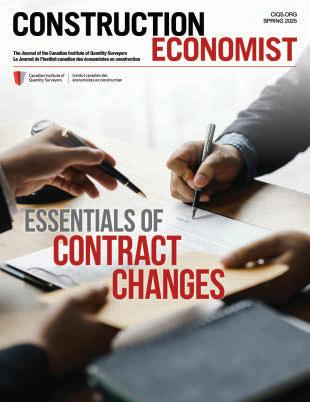



By Ibrahim Oladapo, PQS, PMP

Ethics are the bedrock of professional practice across all disciplines, including ours, as it is critical for maintaining integrity, trust, and reliability. As members of the CIQS, it is imperative that we not only uphold these ethical principles but also understand their profound impact on our profession and broader industry.
In professions ranging from medicine to law to engineering, ethical decision-making is paramount. Similarly, for CIQS members, ethical considerations guide us in navigating complex scenarios with integrity, transparency, and fairness. By adhering to ethical standards, we mitigate risks, uphold professional reputation, and ensure the sustainability of projects and organizations.
The CIQS Code of Ethics and Professional Conduct and Competency framework serves as a cornerstone for our members, emphasizing ethical reasoning and application. This framework is particularly assessed in Part C (Practice Problem) and Part D (Professional Interview) of our Test of Professional Experience, where candidates are evaluated on their understanding and application
of ethical considerations and competencies required by the CIQS.
To uphold and strengthen ethical practices in our industry, CIQS members can implement the following strategies:
• Continuous Education and Awareness: Engage in ongoing training and awareness of ethical standards to stay informed and enhance the ability to apply them effectively in daily practice.
• Integrity in Decision-Making: Uphold honesty, fairness, and accountability in all professional dealings, mirroring ethical standards observed in other fields. In addition, aligning decisions with CIQS standards and industry best practices to maintain ethical integrity.
• Conflicts of Interest Management: Establish protocols for identifying, reporting and managing conflicts of interest, ensuring unbiased decision-making.
• Peer Support and Mentorship: Engage with peers and mentors within the CIQS to discuss ethical challenges and seek guidance. Mentorship fosters ethical leadership and promotes consistent ethical behaviors.
• Compliance and Reporting: Adhere strictly to CIQS National Standards
and By-Laws and promptly reporting any ethical concerns or misconduct to the CIQS to uphold professional standards.
Professional ethics are universal across disciplines, providing a framework for maintaining credibility and trust. For construction estimators and quantity surveyors, integrating ethical decision-making into daily practices not only upholds professional integrity but also contributes to industry growth and sustainability.
For further reference, please refer to the National Standards available on the CIQS website. ■

Ibrahim Oladapo’s career spans three continents and over 18 years in consulting, contracting, academia, and public service. He possesses a master’s degree in project and enterprise management and a bachelor’s degree in quantity surveying. He is a Cost Manager with the Government of Alberta and provides expertise for the planning and delivery of the province’s vertical infrastructure projects. Ibrahim is the Education Director of CIQS and is based in Edmonton, Alberta.


By Karen Cheung, BSc(Surv), PQS, MRICS, MCInstCES Senior Contracts & Commercial Specialist, Lakeland Consulting Inc.
It appears that public organizations worldwide are increasingly adopting collaborative contracting methods for complex and high profile, higher risk projects. This article explores an emerging trend within the Canadian construction industry of a similar contracting method, sometimes referred to as the “Alliancing Contract.” Although the Alliancing Contract may be relatively new to Canada, such mode has been widely adopted in a number of other countries, as further set out later in this article. This paper examines the concepts of alliancing, advantages, potential drawbacks, and important considerations.
Participants: Participants entering the multiparty Alliancing Contract (“Parties”) are typically made up of the owners of construction projects (“Owner(s)”) and the Non-Owner Participants (“NOPs”). The Owner provides funding for the project and retains the ultimate ownership of the asset being developed by the project. NOPs often consist of participants, including designers, consultants, contractors, suppliers, operators and maintainers of the assets to engage in the delivery of the project.
Objective: The alliancing mode aligns the shared interest of the Parties
to deliver the project, achieved through working in a collaborative manner that supports the attainment of collective aims and objectives. Emphasis is placed on the term “best-for-project” with value for money and collective sharing of risks between the Owner and NOPs.
Mechanism: Parties have a collective responsibility for the performance, risk and outcome of the project under a risk and reward compensation regime (also known as the Pain-Gain Mechanism), incentivizing them to achieve the overall success of the project through innovation in delivery, effective project management, and reasonable compensation mechanisms.
Target Outturn Cost (TOC) & Compensation: The estimation of TOC and compensation regime for NOPs are generally based on three components:
➢ Component 1 is Reimbursable Cost. The aggregate of the direct project cost and indirect project specific overhead costs incurred by NOPs in undertaking the project.
➢ Component 2 is NOPs’ fee. The profit and corporate (non-project specific) overheads, which is a fee typically fixed and paid progressively.
➢ Component 3 is Pain-Gain Mechanism. NOPs’ entitlement to a “gainshare payment” or liability of “painshare
The alliancing mode aligns the shared interest of the Parties to deliver the project, achieved through working in a collaborative manner that supports the attainment of collective aims and objectives.
payment,” determined by the alliance’s Actual Outturn Cost (AOC) against the TOC and other agreed key performance indicators such as the safety performance and project delivery time. Overruns and underruns are shared based on a predetermined percentage. Such sharing is typically done on a 50/50 basis. Nonetheless, for the painshare payment, NOPs’ sharing may be limited to the amount of Component 2 Fee (i.e., profit and corporate overheads) which losses beyond the cap are fully borne by the Owner.
Alliancing Contracts typically involve open book accounting to ensure that the costs reimbursed to NOPs are both actually and reasonably incurred. NOPs are required to maintain project records and documentation in accordance with good accounting practices and standards, enabling others to review project cost information on a contemporaneous basis.
Culture: Alliancing is underpinned by trust, openness, transparency, communication, collective accountability and a “no-blame” and “no claim” culture in which participants are expected to waive the right of redress against other participants.
Development: The Union Station Enhancement Project is an example of a Canadian project procured using the alliance-contracting model, where the Owner entered into an Alliance Development Agreement with the successful proponent to develop the design, schedule and cost in 2020, and the Project Alliance Agreement was signed in 2022.1
Alliancing Contract has been successfully refined and adopted in several jurisdictions, including United Kingdom, Australia and Finland, where it is believed that alliancing effectively
facilitated the delivery of infrastructure investment.
For example, both “The Woo Project” and “The East Spar Project” gas field alliancing projects were launched in Australia in 1994. Their successes laid the groundwork for numerous complex municipal and private projects, including the National Museum of Australia, which was completed on time, under budget and to the Owner’s satisfaction.
The following are the perceived benefits of Alliancing Contracts.
Aligned Goals: All participants aim at achieving “best-for-project” with the value for money under a shared “risk and reward” approach, fostering a mutually beneficial outcome in the success of projects.
Open and ongoing communication facilitates the exchange of skills, knowledge, experience and expertise between participants. More value-engineering, innovative and creative ideas are anticipated to enhance the project’s efficiency and cost-effectiveness.
A successful alliance project undertaken in Australia was the “Ipswich Motorway Upgrade: Dinmore to Goodna (D2G) Project” ($1.95 billion AUD federally funded), a complex road infrastructure project undertaken in South East Queensland. Through rigorous management and innovation, the project was delivered approximately 10% under the original budget, six months ahead of schedule, and also achieved all quality benchmarks within the agreed time and cost parameters of the project.2
Avoiding Claims and Disputes: Alliancing Contracts usually contain a “no dispute” clause, which mutually releases the Parties from their liability
to each other and eliminates claims. Unlike the traditional approach where the relationship of contracting parties often deteriorates due to claims and the safeguarding of individual business interests, alliancing promotes the collaborative effort to mitigate adverse impacts on the project and prevent the lengthy and costly dispute resolution processes through early identification and proactive management of risks.
Non-Adversarial Relationship:
Non-adversarial relationships cultivate trust, transparency and close relationships amongst project members. Such a relationship can foster greater transparency in project management, enhancing the tracking of costs, schedules and performance against project benchmarks.
That said, there are constraints and challenges inherent in Alliancing Contracts, in particular: Dependency on Collaboration Skills: Parties within the shared mechanism may rely on the expertise, resources, and capabilities of others. A failure by one party to fulfill its commitments can significantly impact the performance of the others and hinder the success of the project.
High Up-front Cost and Complexity: Substantial work is required to select the right NOPs, to understand NOPs’ behaviours, to develop new processes and to provide training on the management of an Alliancing Contract. For instance, Collaborative and Behavioural Assessments (CBAs) can be used as part of the procurement process for the alliancing project to assess each proponent’s understanding and commitment in relation to collaborative working, along with their behaviours to demonstrate that understanding and commitment. Since the Alliancing Contract requires significant upfront
costs and resources to undertake such assessments, it may not be justified for projects with a low or definable risk profile and those small projects.
Disputes: Projects do not always proceed as planned, with minimal disputes. Failure to establish a robust risk management framework can still lead to a complex and lengthy process for Parties to proactively identify, assess, and manage risks. Such inefficiencies in risk management can compound to disputes, delays and cost overruns of the project.
Insurance: Professional indemnity insurance can be a hurdle, as liabilities are shared among the Parties in Alliancing Contracts. The insurers are likely liable for losses caused by the default made by alliancing participants other than the insured and also waive the right of subrogated claims, resulting in a high insurance premium.
Developing alliances requires culture and behavioural changes from the traditional contracting.
The Alliancing Best Practice published by the HM Treasury sheds light on four fundamental characteristics of successful alliances – “behavioural,” “integrated,” “leadership” and “commercial.” 3
“These characteristics being; an understanding of the behavioural change required, the capability to develop integrated delivery teams, a commercial model that creates the right environment and the leadership required to support the overall change.”
(emphasis in original)
➢ Behaviour: Understanding of the right behaviours at individual and organizational level with the appointment of the right people with the right attitude.
➢ Integration: Multiple organizations form a single delivery entity in an alliance. These organizations need to be highly integrated to work to a common performance structure. Early involvement of different stakeholders facilitates effective integration and provides a greater degree of influence over the release of value.

➢ Leadership: Committed, visible and consistent leadership to deliver effectively in a collaborative environment. Establish clear and simple purpose and common goals across the alliance. Open decision making and governance processes to enable the creation of an effective alliance environment, support the development of an aligned organization and provide a systemic management approach.
➢ Commercial: Commercial incentives to reward the delivery of agreed outcomes and drive the required behaviours.
In short, the capabilities to adapt to this type of procurement, integrate the alliancing mindset into the team, cultivate the required leadership skills and develop proper alliancing commercial modes are imperatives for the procurement and delivery of Alliancing Contracts.
Besides, the National Alliance Contracting Guidelines specifies two thresholds to be considered for an alliance4:





➢ Project Value: Considering the high initial start-up management costs for both Owners and NOPs, alliancing is generally not worthwhile for infrastructure projects under $50 million (AUD).
➢ Resourcing: The Owner internally shall have enough resources to effectively represent and manage its interests against external parties and Alliancing Contracts.
The Guidelines further suggests that the optimum solution for risk and opportunity sharing may be either the Owner or NOPs to retain a particular risk. It illustrates, through an example, that the Owner may be the only party in a position to influence and manage the risk of essential land acquisition/resumptions for a time critical project.
The writer believes that a balanced risk allocation does not necessarily mean an equal sharing of every risk between the Parties. Certain risks may be excluded from the collaborative risk-sharing approach in the commercial arrangements to ensure a fair return for the work performed and the risks undertaken.
The Ipswich Motorway Upgrade Project successfully demonstrated several of the above mentioned features, as outlined through the following measures5:
• Development of a blueprint prior to the commencement of construction – Outlined how things needed to be done.
• Respect – Valued the knowledge, skills, contribution, and role of others on the project.
• Leadership – Demonstrated a strong commitment to building a culture where everyone was passionately aligned with a shared vision and goal. Exhibited strong management and coordination skills, including the appointment of sufficient managers to improve communications and overall project efficiency.
• Recognition – Acknowledgement of individual’s achievements through the formal Reward and Recognition Program to publicly acknowledge and reward the performance of staff.
• Innovation – Encouraged people to introduce and run with new ideas.
Alliancing marks a significant transformation in project management, risk apportionment, company mindsets and relationships among project stakeholders. Given the number of ongoing and planned mega, complex and long-term projects in the coming years, the alliancing contracting likely becomes more prominent, particularly for projects where scope and risks are difficult to be defined or quantified at the pre-contract stage.
The alliancing mode places great importance on selecting the right mix of people. It is time to gear up and
position our profession as the right people for this evolving contractual landscape. Are you ready to be part of the alliancing journey? ■
**This article does not constitute legal opinion and/or legal advice in respect of any particular nuance or situation that may arise.**
1. Infrastructure Ontario (2022, January 31). Project Alliance Agreement Finalized for the Union Station Enhancement Project [Press Release (Archives)].
2. Australian Construction Achievement Award (2012). Origin Alliance Ipswich Motorway Dinmore to Goodna Project. Australian Construction Achievement Award Technical Paper.
3. HM Treasury (2014). Improving Infrastructure Delivery: Alliancing Best Practice in Infrastructure Delivery.
4. Australian Government – Department of Infrastructure and Regional Development (2015). National Alliance Contracting Guidelines – Guide to Alliance Contracting.
5. Australian Construction Achievement Award (2012). Origin Alliance Ipswich Motorway Dinmore to Goodna Project. Australian Construction Achievement Award Technical Paper.

Karen Cheung is a Professional Quantity Surveyor and Chartered Surveyor with experience working on projects in Canada and Hong Kong. Karen continues to be involved in project planning/design, cost estimating including during the pre-contract, delivery, and post-construction phases of projects.






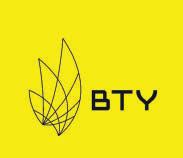






By Ayo Daniel Abiola, P.Eng, PQS

Canada is one of only two countries that border three oceans on a contiguous landmass – a fact that has given rise to the familiar phrase “from sea to sea to sea.” At the nation’s inception, transportation played a key role in nation-building. For example, construction of the Canadian Pacific Railway (CPR) was critical to uniting the country and enabling provinces
such as British Columbia, and territories like the Northwest Territories, to join the Canadian Confederation. Based on data from the year 2000, the average Canadian travels up to 60% more kilometres annually than the average European, largely because of Canada’s vast geographic expanse. Transportation is a critical component of Canada’s infrastructure, accounting for
significant energy use and contributing substantially to the nation’s emissions. In 2021, the transportation sector, including all vehicle types and fuels, was responsible for 28% of Canada’s overall greenhouse gas (GHG) emissions. This makes it a prime target for decarbonization efforts, addressing both the embodied emissions from infrastructure

development and the operational emissions from transportation modes.
Investments in Infrastructure
Canada’s projected investment in transport infrastructure from now until 2050 is expected to significantly surpass the spending of the previous 25 years. This development is driven by factors such as population growth, aging infrastructure, climate
resilience initiatives, and technological advancements. For example, the total projected investment value for Canada’s 100 largest public infrastructure projects has reached an all-time high of over CAD $300 billion. The transportation sector, including transit and energy, is leading this investment surge.
In early 2025, Alto, a high-speed rail project dubbed Canada’s “largest-ever infrastructure project” was announced. Its estimated cost is $80–$120 billion, with a $3.9 billion design phase already underway. Massive construction activities will undoubtedly increase the country’s emissions footprint with materials like asphalt, concrete, and steel. These investments are also aimed at modernizing the sector’s operations to make them safer, more innovative, and greener.
The focus on climate resilience and emissions reduction is also shaping future investments, with mandates to cut transport-related emissions by 40% by 2030. These include adopting electric vehicles and enhancing urban delivery systems. The Alto project for example, is planned to span approximately 1,000 kilometers of dedicated, electrified railway lines connecting major cities such as Toronto, Ottawa, Montreal, and Quebec City, corridors known for their clean (hydro and nuclear) electricity grids.
Canada is resource-rich, and beyond moving people and goods, resources must be transported over great distances using dedicated systems. In 2025, the Government of Canada is expected to earmark millions of dollars for various resource supply chain corridor projects designed to enhance the network for moving commodities. In the run-up to the April 2025 federal election, as a global trade war driven by tariffs intensified, political leaders proposed several energy corridors intended to mitigate economic pressures by decreasing reliance on United States trade, while enhancing internal commerce. For example, the “Canada First” National Energy Corridor and the National Trade Corridors, supported by major federal parties, are expected to spur billions in investment to develop transmission lines, railways, and pipelines for transporting energy, critical minerals, and the 7,000 km multimodal Northern Corridor is among the boldest proposals in national development, with an estimated cost of $100–150 billion.
The Northern Corridor would comprise roads, railways, pipelines, and communication infrastructure designed to connect Canada’s northern and near-northern regions (including mining sites, forests, and agricultural lands) with the south.

Figure 1: Schematic of the Canadian Northern Corridor Project

A multifaceted approach is necessary to balance infrastructure development with emissions-reduction goals.
Canada is driven to continue investing heavily in transportation infrastructure to connect people across vast territories, boost economic growth, and enhance climate resilience and sustainability. New infrastructure, however, often generates significant greenhouse gas emissions during construction, stemming from the production of materials like concrete and steel, and the energy required in construction processes. Moreover, expanding transportation networks can lead to increased vehicle use, potentially resulting in higher emissions if fossil fuels remain the dominant energy source. Therefore, a multifaceted approach is necessary to balance infrastructure development with emissions-reduction goals. The multifaceted approaches being implemented include:
• Clean Energy Transitions: The federal Clean Electricity Strategy aims to boost investment in reliable, non-emitting, electricity sources to power various sectors of the economy, including manufacturing and transportation infrastructure. This strategy emphasizes grid development to align with NetZero goals. Additionally, clean fuels such as ethanol, biodiesel, and renewable natural gas are being promoted to encourage industries to adopt greener energy while supporting sustainable infrastructure projects.
• Electrification of Transportation: Along with the expansion of transportation networks, Canadian jurisdictions are investing in transitioning public transit to either electric or hydrogen-powered systems, while expanding electric vehicle (EV) charging infrastructure. For example, as part of its commitment to sustainability and greenhouse gas emissions reductions, BC Transit plans to introduce 115 battery-electric buses (BEBs) across communities including Victoria, Kamloops, Kelowna, Nanaimo, and Whistler, and to install more than 100 EV charging stations at strategic locations.
• Collaboration and Partnerships: These massive transportation projects, often costing billions of dollars, typically involve collaborations across multiple levels of government. Major projects such as the Montreal Metro Blue Line expansion, the Calgary Green Line LRT project, and the BC Transit electrification project, are being delivered through funding partnerships among the Government of Canada, provincial governments, and various local governments.
Reducing overall emissions in the transportation sector requires careful consideration of design, material selection, procurement practices, and construction standards. Some ongoing projects are making significant progress in this area. For example, the Quebec City Tramway
and Montreal Metro projects incorporate locally sourced materials, recycled steel, and concrete with lower embodied carbon. The Calgary LRT project is designed to optimize energy use and minimize waste through smart urban planning, while Ontario’s subway projects include environmental impact assessments throughout both construction and operation. As Canada proceeds with plans to expand transportation infrastructure, setting clear decarbonization goals, as well as strong policies and standards, will be crucial. These policies should incentivize green practices, foster collaboration, and support innovation to accelerate sustainable solutions. ■

Ayo Daniel Abiola, P.Eng, PQS, is the manager of Hanscomb’s Saskatchewan office and a seasoned Mechanical Quantity Surveyor. Combining his expertise as both a Professional Engineer and a Quantity Surveyor, Ayo effectively balances cost, sustainability, and performance in new construction and renovation projects across Canada. Ayo is an ASHRAE Certified Decarbonization Professional (CDP) and a recognized expert in sustainable infrastructure. He has trained over 300 public and private sector professionals in system analysis methods for sustainability planning. He is licensed to practice engineering in Ontario and Saskatchewan and is deeply committed to environmentally responsible and cost-effective building solutions. Ayo lives in Regina, Saskatchewan.
By Brandon Roy, BA, CEC, GSC
Iremember the first time when, as a young estimator, I had to stand my ground and assert myself for a specific reason on a project. It was regarding the use of an unknown mechanical contractor from a smaller town in eastern Ontario. We were pricing a renovation for a big box store, which happened to be a major return client at the time. We had completed many similar projects for this client, with similar scopes and had used many of the same trades on these projects with great success.
The location of the store was farther away from our normal contractors, so I had worked hard to expand my
search for more local talent that would be willing/capable to take on the work. In the end, I found a local mechanical contractor who had been around for decades (over 50 years), but they were a smaller outfit. Their pricing was half (yes HALF!) of our normal go-to trusted trade. Obviously, for any good QS this should be raising about a million red flags, as it did with me initially. However, I had also spent the better part of three weeks reviewing and re-reviewing the scope with this contractor and ensuring that when they did provide their price, I could trust it.
Here comes the challenge: at my company, we always closed projects
as a team. All team members can provide input regarding pricing, trades, locations, etc., to ensure that we put our best foot forward. So, when my boss at the time was extremely apprehensive about carrying a trade that much lower than our known partners, I had to stand my ground and, for the first time, really put my reputation and work on the line. It was a big risk. We decided to close with the low trade and, in the end, it turned out to be a great working relationship and a successful project.
There will come a time in every QS/Estimators’ career when they will have to stand their ground on a

There will come a time in every QS/ Estimators’ career when they will have to stand their ground on a decision that they believe is right and then face the consequences of that decision.
decision that they believe is right and then face the consequences of that decision. The hope is that when that time comes, you are able to approach the situation with solid footing. There are several ways to be successful in doing so, and I would like to outline some tips to improve your success rate on these “stand-your-ground decisions,” because, believe me, they won’t all be successes!
Due Diligence: A straightforward concept that can be challenging to
fully achieve. Completing your due diligence on a decision allows you to more easily/confidently make the decision. It will also provide you with the necessary backup information that you will need, if your decision is challenged. Whether it’s advocating for a new/unknown contractor or an approach to a submission or a design recommendation, complete the due diligence and provide the backup.
Professionalism: There are many ways to stand your ground on a

decision and some are better than others. Approaching your decision from a place of professionalism is key. The decision must be presented in a way that others are willing to listen to and accept or at least provide a professional rejection response. If you approach your decision from an emotional state, it may not be presented in the best possible manner and leave it at risk of being rejected outright or, worse, ignored. Not everyone will agree with your decision and it may not always be accepted. Becoming emotional and unprofessional in those circumstances only diminishes your ability to provide comprehensive and strategic advice in the future.
Own It: If you stood your ground and made use of the first two tips and presented the decision/ idea with proper due diligence and professionalism, it is now time for you to own it. Own the wins and especially own the losses; in the end, these will prove to be critical learning tools for your development and decision making in the future.
Pick Your Spot: Knowing when to stand your ground on a decision is just as important as knowing on which decisions to stand your ground. Not every project/client will be receptive to alternative approaches, trades, products, methodologies etc. Understanding the project/client in these cases can dictate your success in standing your ground on a situation and allow you to build trust with the client for future ideas/decisions that you may make or propose. ■

Brandon Roy is a Senior Estimator with a general contractor in Ontario. He has a diverse portfolio spanning all sectors of construction in commercial, design-build industrial, institutional, Long-Term Care and Multi Family Residential. Brandon holds a Bachelor of Arts, History degree with a minor in Classical Military Tactics from Wilfrid Laurier University and a Construction Estimator Certificate from Conestoga College.
By Huw Williams
The start of spring brought with it the start of election season in Ottawa, and the season of rebirth coincided with a rebirth in the federal Liberal Party, under the leadership of Mark Carney. At the time of writing, the Liberal Party had seen a resurgence in polling and had pulled ahead of the Conservative Party into majority government territory. The election focused on one critical issue: Canada’s relationship with our biggest trading partner, the United States. This issue, and the questions around the stability of our relationship with the U.S., led to a national consensus that what Canada needs to do to protect its economy and spur widespread economic growth is to build.
Across the political spectrum and from public and private decision makers, there has been broad national recognition that Canada must build up its national trade infrastructure and expand investments in critical industries. Provincial budgets across the country have seen investments in infrastructure projects to support industries and workers from coast to coast. From expanding mineral construction in Manitoba, to improving community infrastructure and supporting housing developments in British Columbia, to increasing home construction in New Brunswick, provinces have worked quickly to make investments in their communities to mitigate the impacts that tariffs will have on economies and affordability.
On the campaign trail, each of the parties included construction and infrastructure investments as a key piece of their pitch to voters.
Conservative leader Pierre Poilievre presented bold plans to build out

infrastructure in Northern Ontario to support expanded operations in the Ring of Fire, create “Shovel Ready Zones” to reduce red tape and permitting for projects, expand training and apprenticeships for workers in skilled trades with his ‘More Boots, Less Suits’ plan, and create a National Energy Corridor across the country.
Not to be outdone, Liberal Leader Mark Carney also presented bold infrastructure solutions to support Canada’s economy during unstable times. Mr. Carney pledged that, if elected, his government would invest in a new Trade Diversification Corridor Fund and build infrastructure to help diversify Canada’s trading partners. Furthermore, the Liberal leader pledged to create a new entity called Build Canada Homes, with the goal of doubling the pace of construction to almost 500,000 new homes a year.
From coast to coast to coast, it has become clear that construction needs to be a critical part of public policy discussions. CIQS has and will continue to advocate for infrastructure to be front and centre in policy across Canada. The impact of tariffs on the Canadian economy has made Canada’s political parties think big about what can be accomplished. CIQS has long advocated that governments at the federal and provincial levels prioritize infrastructure development and the use of PQS and CEC professionals at every stage of a project to ensure cost assurance and maximum return on investment and governments have now started stepping up.
CIQS has also been working hard to educate its members on the impact that tariffs will have on the construction industry. In March, CIQS and Impact Public Affairs hosted a free webinar for
members titled, “Trade Wars – What Tariffs Mean for CIQS Members and Exploring Solutions.” Panelists included CIQS Chair Tammy Stockley, PQS(F), CIQS Vice-Chair Seán Hollywood, PQS, Kevin Drake, PQS, a principal from Tech-Cost Consultants Ltd, and this author. The webinar covered the current changing political landscape in Canada, the impact that tariffs will have on the construction industry and how it could impact CIQS members. The discussion also included what members can do to prevent the worst impact of tariffs on their business. CIQS leadership and Impact will continue to advocate and educate decision makers across the country on the importance of PQS and CEC professionals and how damaging a prolonged trade war could be for construction, at a time when Canadians all agree that its time to build.
Regardless of which party emerged victorious on April 28th, CIQS was prepared to promote its message on Parliament Hill and with provincial governments across the country. While polling had shown that it is likely there will be another four years of Liberal government, there are always new MPs, giving CIQS and its members a fresh audience to educate and a new group of potential champions in Ottawa. CIQS is ready to hit the ground running and make this next year a critical opportunity for advocacy. ■

Huw Williams is the President of Impact Public Affairs in Ottawa, Ontario. Huw provides strategic advocacy advice to the Canadian Institute of Quantity Surveyors.
By Shane McKernan, PQS, GSC, B.Tech
PROJECT:
QEII Halifax Infirmary Expansion Project
LOCATION: 1796 Summer Street, Halifax, NS
OWNER/DEVELOPER(S): Plenary Americas, PCL Investments Inc.
Government of Nova Scotia
CONSTRUCTION MANAGER: PCL Constructors Canada Inc.
Stats:
Size: 1.2 million SF (111,483m2), 14-storey building.
Cost: Initial project budget: $7.4 billion DBFM (Design-BuildFinance-Maintain).
• $4.5 billion for construction, $2.9 billion for maintenance.
Schedule: Six-year anticipated construction period commencing
Notes:
• 14-floor structure housing 216 acute care beds, including a 48-bed ICU and specialized inpatient units.
• 16 operating rooms, expanded from original plans to meet surgical demands.
• Doubled in size compared to the current facility, designed to handle increased patient volumes efficiently.
• LEED certification target, emphasizing
• Light-infused workspaces to enhance staff well-being and patient comfort.
The Halifax Infirmary Expansion Project is set to redefine healthcare infrastructure in Nova Scotia, marking the largest healthcare initiative ever undertaken in Atlantic Canada. With a budget of $7.4 billion CAD, this ambitious redevelopment aims to deliver cutting-edge medical facilities



Located in downtown Halifax, the project centres on the construction of a modern 14-floor acute care tower. This state-of-the-art facility will house 216 acute care beds, 16 operating rooms, a 48-bed intensive care unit (ICU), and an expanded emergency department that is double the size of the current one. Additionally, it will feature a satellite diagnostic imaging department, upgraded laboratory spaces, and enhanced treatment areas.
The new tower is designed not only to replace aging infrastructure like the Victoria General Hospital but also to provide a welcoming and efficient environment for patients and healthcare professionals alike. The facility will incorporate advanced equipment and technology, creating a contemporary workplace that supports clinical excellence
and aids in recruiting top-tier medical staff.
The project is being managed by Plenary PCL Health (PPH), a joint venture that includes PCL Construction, Plenary Americas, Arcadis, and B+H Architects.
Construction began with enabling works in 2024, including site preparation and demolition of existing structures such as the Robie Street parking garage. The main construction phase commenced in early 2025, with cranes installed and foundation work underway.
Key milestones include:
• 2025-2027: Tower construction progresses to full height by 2027.
• 2028-2030: Interior finishes, equipment installation, and commissioning.
• 2031: Final completion and opening in fall of 2031.
This transformative project promises substantial benefits:
• For patients: Improved access to care with expanded services and a more navigable facility.
• For healthcare professionals: A modern workplace equipped with advanced technology designed to enhance operational efficiency and attract skilled staff.
• For the community: Thousands of jobs during construction and long-term improvements in healthcare delivery.
While the project has faced criticism over its cost escalation from initial estimates of $2 billion to $7.4 billion CAD, Health Minister Michelle Thompson emphasized its necessity given the province’s growing healthcare demands. The investment includes $4.5 billion for construction and $2.9 billion for maintenance over 30 years.
The QEII Halifax Infirmary Expansion Project represents a pivotal moment in Nova Scotia’s healthcare history. By replacing aging infrastructure and enhancing clinical capabilities, the project addresses the region’s growing healthcare needs while providing a modern, efficient workspace for healthcare professionals. The project’s significance extends beyond its physical scope, as it underscores Nova Scotia’s commitment to improving patient outcomes and attracting top medical talent. Upon completion in 2031, this facility will not only elevate healthcare standards in Halifax but also serve as a model for future healthcare infrastructure developments across Atlantic Canada. ■

Shane McKernan is the Director of Preconstruction for Axiom Builders, based out of Vancouver, BC. With over seventeen years of experience, Shane’s a seasoned construction professional specializing in cost consulting & project management. He is a Past President of the CIQS –BC Chapter, where he served for ten years and is a current Assistant to the Construction Economist editor.
By Udayan Chatterjee, B.Tech, MRICS, PMP, PSP, PMI-SP Associate Director, Contracts & Commercial Lakeland Consulting Inc.
Performance indicators of the Canadian Construction Industry were revisited and studied in March of this year, and as usual, the study revealed interesting insights into its GDP, composition and changes in investments, construction price indices across multiple cities, housing starts composition and changes, and composition of employment.
Data indicates a sharp rebound in the construction industry’s GDP over the past year, after a concerning downward trend in the preceding two years. The construction GDP increased from $162.5M in January 2024 to $168M in
January 2025, which is a year-over-year increment of 3.4%. This was a much awaited upward move in the GDP data, after a considerable period of decline. For instance, the construction GDP decreased from $165.7M in January 2023 to $162.5M in January 2024, which was an annual decline of 2%.
The year-over-year increase, from January 2024 to January 2025, in investments in residential buildings and non-residential buildings have been 2.4% and 2.7% respectively.
In terms of composition, as of January 2025, the investments in residential buildings (66%) have been observed to be almost double the investments in non-residential buildings (34%).
The latest data from Statistics Canada indicates increases in building construction prices for both residential and non-residential projects across eleven Canadian cities. The indices values are based on 2017 data as the base (Index Value = 100).
Residential construction prices have been observed to be the highest in Toronto (Index Value = 203.3), followed by Calgary (Index Value = 190).
Whereas non-residential construction prices have been observed to peak in Ottawa-Gatineau (Index Value = 160.8), very closely followed by Toronto (Index Value = 159.6).

2. Composition & Changes in Investments in Construction, as at January 2025 Statistics Canada.
Table 34-10-0286-01 Investment in Building Construction
3. Construction Price Indices Across Metropolises Statistics Canada.
Table 18-10-0276-01 Building construction price indexes, by type of building Index, 2017 = 100

4. Housing Starts Composition, as at Q4 2024 (Residential Construction) Statistics Canada. Table 34-10-0135-01 Canada Mortgage and Housing Corporation, housing starts, under construction and completions, all areas, quarterly

5. Changes in Housing Starts, Q2 to Q4 2024 (Residential Construction) Statistics Canada.
Table 34-10-0135-01 Canada Mortgage and Housing Corporation, housing starts, under construction and completions, all areas, quarterly

6. Composition of Employment in All Industries Vs Construction, as at February 2025 Statistics Canada.
Table 14-10-0022-01 Labour force characteristics by industry, monthly, unadjusted for seasonality (x 1,000)
The data studied also indicates that the prices for residential construction have risen far more drastically across the various metropolises, when compared to the prices for non-residential construction since 2017.
In the last quarter (Quarter 4) of 2024, the housing starts composition percentages was dominated by Ontario, like the previous quarters, which constituted 29% of the housing starts among the four major Canadian provinces. This was followed by Quebec (27%), Alberta (23%) and British Columbia (21%).
However, interestingly, in terms of percentage change in the housing starts in Quarter 4 of 2024 when
compared to Quarter 2 of 2024, a steep decline of 14% was observed in Ontario, followed by a minor decline of 2% in British Columbia. A sharp increase of 13% was observed in the housing starts in Alberta, followed by a steady increase of 6% in Quebec.
As observed in February 2025, the composition of employment within the construction industry continues to highlight a notable gender disparity. Males dominated the workforce, similar to the data collected previously, constituting 86% of the industry’s employment, while females comprised only 13%. This data contrasts with the more balanced gender distribution seen across the total working population of
Canada, where the male to female ratio is approximately 52% to 48%. This persistent gap in the gender representation within the construction sector continues to emphasize the ongoing challenge of achieving gender equality in this industry. ■

Udayan Chatterjee is a commercial and project management professional with expertise in quantum assessments, schedule forensics, contracts and claims management. He holds a bachelor’s degree in electrical engineering, Diploma in Construction Engineering and has worked on various large-scale transportation, mining and commercial construction projects across the globe.

Joanne Lynn Stregger (nee Whitehead), born June 11, 1952, to Thomas and Ethel Whitehead, passed away peacefully at home on January 23, 2025, a short nine months after receiving a cancer diagnosis.
Joanne was the loving wife of Evan Stregger, PQS(F), with whom she shared 53 beautiful years of marriage. Together, they raised three children: Matthew, Jason, and Sarah (Ryan), who were the light of her life. Joanne was also a dedicated grandma to her four cherished grandchildren: Declin, Hayden, Hayley, and Kai.
Joanne grew up in Burnaby, where she attended Inman Elementary School, Moscrop Junior High, and Burnaby Central High School. She went on to earn a diploma in Building Technology from BCIT, where she met her future husband Evan. Together, they built a life and a home in New Westminster, where they also founded their company, Costex Management.
Joanne earned certification with the Canadian Institute of Quantity Surveyors as a Construction Estimator Certified (CEC). She also served as the Executive Director for the Quantity Surveyors of BC for over 19 years (1987 to 2006), leaving her mark on the industry.
Joanne will be desperately missed by her family, friends, and colleagues, but her memory will live on in the hearts of all who were fortunate to know her. Her light will live on through them.


Donald Hamlett, PQS(F)
Donald Hamlett passed away in January 2025 and is survived by his wife Margaret, his son Phil and family and his daughter Susan and family.
He studied at the University of Manchester in England and graduated with a degree in Building and then spent four years in a professional quantity surveyor’s office. In 1954, he joined the Royal Engineers of the British Army and was posted in Kuala Lumpur, Malaysia, where he was stationed at headquarters. At headquarters, he prepared documents for bidding, received the prices, and prepared the contracts.
In 1956, Donald was one of many aboard the Empress of France, bound for Canada. Docking in Montreal, he made is way to Toronto by train with the intention of finding a job. Two days after his arrival in Toronto, he went in search of Malcolm Milton, who later became the first president of the CIQS, to ask if he knew of anyone hiring quantity surveyors. Malcolm suggested a job with Alex Greenspoon of Estimating Quantities and in less than two weeks he had successful obtained employment.
Donald became a designated member of the CIQS in 1960, received the CIQS Award of Merit in 1976, and Fellow in May 1981. He retired from Quantity Surveying in 1994. ■

The CIQS would like to welcome the following new members who have joined the Institute from February 15 – April 24, 2025.
Alireza Ashrafi
Amandeep Singh
Amir Badpei
Bogadage Sameera Vidarshana Perera
Brittany Barnes
Dan Shakeshaft
Dana Bukarum
Diksha Wadhwa
Dona Ann Rajan
Ei Ei Phyo
Gayasthi Vithanage
George Friedrich Andres Aguinaldo
Gokhan Kaya
Hamid Asad Poor Kiklou
Hannah Glynn
Harminder Virdi
James Greig Hamilton
Janhavi Praveen Monga
Jannelle Van Den Bosch
Jibin Biju
Joel Nathan Van Maren
Jose Alejandro Perez
Jose Ruiz Acebo
Kaveesh Vihanga Cooray Nawalage
Maathanki Thayaparasarma
Mahmoud El Mikabaty
Man Hing Chau
Manmohit M. Chawla
Manu Sinha
Masood Ahmed
Matthew Jonathan Szczesny
Michael Wai Mah
Mohammad Elkhair Elhaj
Mohammad Zaman Amir
Mostafa Ahmadi
Mushrraf Hussain
Obsa Samuel Tefera
Odebode Oluwole Ojo
Olajide Friday Akinola
Rinku Mary John
Romain Tantikulpanich
Samo Peter Sadek
Samuel Smart Adu
Sanju Lakshan Dharmasena
Seyed Mohammad Fatemi
Thesma Hansani Pituwala Liyanage
Ting Kwan Hui
Yasser Al Zalak
Yat Hin Wu
Yujun Chen
Zaed Sahem
Zohaib Hussain

CIQS – British Columbia
Adrian Uy, CEC
Dona Ann Rajan, CEC
CIQS – Members at Large
Iftikhar Ahmed Khan, CEC
Mohamed Elkhair Elhaj, PQS
Odebode Oluwole Ojo, PQS
CIQS – Maritimes
Olawale Ogunduyile, PQS
CIQS – Ontario
Abdurahman Masud, CEC
Abisola Somorin, PQS
Amir Badpei, CEC
Arshdeep Kaur, PQS
Benyam Areda, PQS
Damon Liu, CEC
Dan Shakeshaft, PQS
Harmen Marskamp, PQS
Hamid Asad Poor Kiklou, CEC
James Greig Hamilton, PQS
Karl Keyrou, CEC
Maathanki Thayaparasarma, CEC
Maurice Saonoy Remigio, PQS
Michael Amirthanathan, PQS
Mikhail Kanev, CEC
Myra Donna Cruz, CEC
Narjes Gisoo, CEC
Sacha Kyle Aitkens, PQS
Temitope Grace Fatukasi, PQS
Thamindu Lorensu Hewa, PQS
Yasser Al Zalak, CEC
Yat Hin Wu, PQS
CIQS – Prairies and NT
Amanda Mitternacht, PQS
Atinuke Ettu, PQS
Gokhan Kaya, CEC
Jenalyn Julian, CEC
Kethaki Maneka Rathnayake
Rathnayake Mudiyanselage, CEC
Yana Dybenko, CEC
CIQS – Québec
Seyed Mohammad Fatemi, CEC
As we continue to face an uncertain market, the role of the PQS and CEC professionals will remain critical in ensuring the construction sector remains financially sustainable. Their deep knowledge, expertise, and commitment to the highest standards of professionalism enable them to be the trusted partners our industry needs to navigate market volatility.
The CIQS is committed to supporting our members as they adapt to the challenges ahead. Through ongoing professional development, collaboration with industry stakeholders, and the promotion of best practices, we are confident that our members will continue to play a central role in shaping our future and being catalysts for progress.
A resilient and sustainable construction industry is key to creating long-lasting impact, both environmentally and economically. It’s exciting to think about how PQS and CEC members will continue to drive innovation, foster collaboration, and lead the way in making those changes a reality. ■
Tammy Stockley, PQS(F), MRICS, GSC, AET, began her career in Quantity Surveying in 1992 after graduating from Architectural Engineering Technology in St. John’s, NL. Her professional career roles evolved from cost planner, cost consultant, senior cost consultant, associate, associate director, and to director in her current employment position.
de prendre des mesures correctives avant que les dépassements ne deviennent des problèmes financiers importants. Ce niveau de prévoyance et d’examen financier renforce la résilience des projets de construction et leur permet de résister à la volatilité du marché.
Mettre l’accent sur la collaboration et l’innovation
En période d’incertitude, la collaboration est essentielle pour garantir la réussite de tout projet de construction. Les professionnels ÉCA et ECC sont des conseillers de confiance en matière d’économie de la construction. Ils travaillent avec les équipes des parties prenantes du projet, les entrepreneurs et les maîtres d’ouvrage pour trouver des solutions innovantes aux problèmes de coûts. Une approche collaborative est essentielle pour identifier les matériaux alternatifs, les méthodes de construction et les stratégies d’approvisionnement qui peuvent contribuer à minimiser les coûts et à maximiser le retour sur investissement. Nos membres peuvent améliorer la précision et l’efficacité de l’estimation des coûts et du suivi des projets grâce à des mises à jour en temps réel des coûts des projets, ce qui permet aux équipes de réagir rapidement aux fluctuations des prix du marché et de procéder aux ajustements nécessaires.
Alors que nous continuons à faire face à un marché incertain, le rôle des professionnels ÉCA et ECC demeure essentiel pour assurer la viabilité financière du secteur de la
construction. Leurs connaissances approfondies, leur expertise et leur engagement à respecter les normes de professionnalisme les plus strictes leur permettent d’être les partenaires de confiance dont notre secteur a besoin pour faire face à la volatilité du marché.
L’ICÉC s’engage à soutenir ses membres dans leur adaptation aux défis à venir. Grâce au développement professionnel continu, à la collaboration avec les parties prenantes du secteur et à la promotion des meilleures pratiques, nous sommes convaincus que nos membres continueront à jouer un rôle central en « façonnant notre avenir et en étant des catalyseurs du progrès ».
Un secteur de la construction résilient et durable est essentiel pour créer un impact à long terme, tant sur le plan environnemental qu’économique. Je suis passionnée par l’idée que les membres ÉCA et ECC continueront à stimuler l’innovation, à favoriser la collaboration et à montrer la voie pour faire de ces changements une réalité. ■
Tammy Stockley, ÉCA(F), MRICS, GSC, AET, a débuté sa carrière en économie en construction en 1992 après avoir obtenu son diplôme de technologie des études techniques à St. John’s en Terre-Neuve-et-Labrador. Au cours de sa carrière professionnelle, elle a occupé les rôles de planificatrice des coûts, consultante en coûts, consultante principale en coûts, associée et directrice associée, avant son poste actuel de directrice.




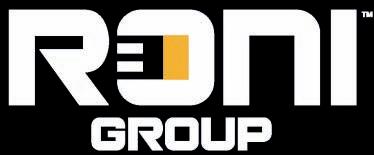
LEAD ER IN M ULTI D IS C IPLINARY CONS TRUCT ION AND IN FR ASTRUCTURAL SER VI C ES F OR PUBL IC AND PRI VATE SE CTORS

DEMOLITION

FORMING
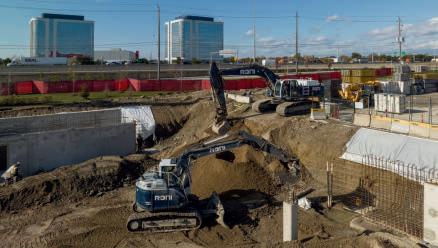

SHORING

LANDSCAPING
EXCAVATING

WATERPROOFING
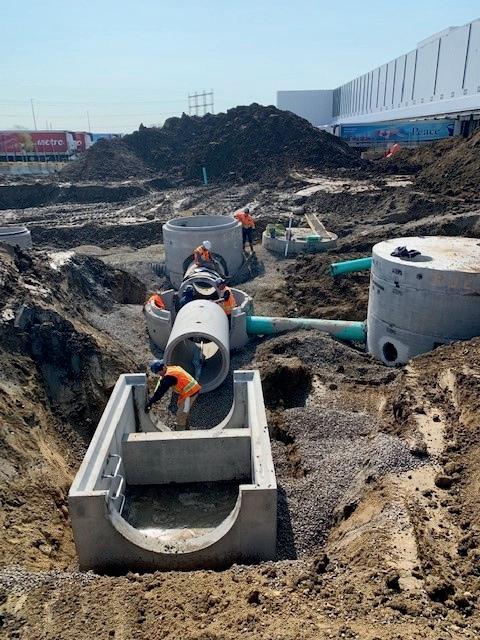
CIVIL